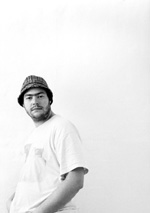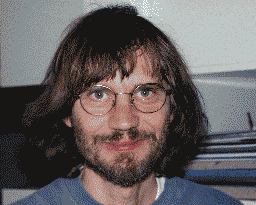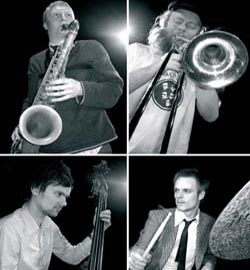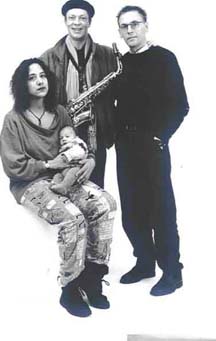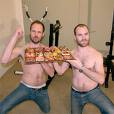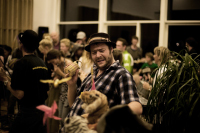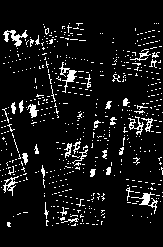
Home
Articles
Reviews
Hot Links
About Us
Improvised Music in Denmark by Kresten
Osgood
|
|
|
Since the 50´s Denmark has had a reputation as a country with a strong love for jazz. Artists like Dexter Gordon, Stan Getz, Oscar Petiford, Ben Webster and Kenny Drew lived and worked in Copenhagen and helped educate that generation of players (many of whom are still around and are generously sharing their knowledge with the younger generation). At this time there were also some hip club owners who presented the avant-garde and people like Albert Ayler were able to play here before they were discovered in the U.S. Cecil Taylor played in Copenhagen for two weeks straight with Sunny Murray and Jimmy Lyons in 1962. This exposure to the new thing started the first wave of improvised music in Denmark, but it was only a hand full of people. Mainstream was still the main thing being played in the clubs.
A major change happened in the mid 90´s. A new generation of players hit the scene. They challenged the general stylistic perception which was prominent at the time. Back then everybody belonged to a camp. Either you were a bebop/modern jazz player and was concerned with playing beautifully over the changes and keeping the form and all that or you were an improvisor, thinking conceptually or abstract with little interest in the past. I am sure you realise that this is a generalisation and that there were a few people who saw things differently, but this was the overall vibe of the scene (which interestingly enough reminds me of the scene in New York in 2006). These players brought a new urgency to the music. They were burning on stage, playing with tremendous power and conviction. Their inspiration came from every kind of music. They were listening to country music, rock, african music, singer songwriters, jazz... everything. These players are in their late 30´s today and they are in my opinion the main reason that the scene in Denmark is like it is. Two bands should be mentioned here: "When Granny Sleeps" and "Once Around the Park".
And here are some names of players from that 90´s wave: Mads Hyhne, Anders Mogensen, Nils Davidsen, Michael Finding, Rune Funch, Niclas Knudsen, Anders Christensen, Kasper Tranberg, Jacob Dinesen. These people are very much active today and are still part of the center of the improvised scene... The Danish scene is mostly whats going on in Copenhagen, but a few smaller cities such as Odense, Ålborg, and Århus also have their improvisors. However, most of these people are also mixing with the Copenhagen scene. What is great about the music community in Denmark is that it is so small that everybody is in contact with each other. It doesn¨t mean that everybody plays with eachother, but you know each others music and it is easy to make a statement that people will hear. Because everything is so small, what goes on at a few jam sessions is extremely important and particularly one club became the center of everything from around 1998 until 2003. The place was called The Children's Theater and was located in Christiania (which is a kind of renegade part of Copenhagen occupied by some hippies since the early 70´s... that was probably the shortest version of that story ever written). The atmosphere in this club was very free and they weren´t trying to make any money. The club opened around 9pm and closed after 6am. everybody who played music and their friends got free drinks and there was no control over what was going on on stage at all. Sometimes somebody from Greenland would get up and start singing songs from his native country accompanied by some dogs fighting and a guy on violin sitting in the audience. Other times the great bebop guitarist Doug Raney would be playing standards and often the great Luther Thomas would improvise on his horn for hours and anybody could join in. Sometimes these sessions would turn into something that reminded me of pagan rituals, with people in the audience dancing abstract while you were playing, other times it would be more like a sing-a-long and at times concentrated listening.
Somehow all of this
created a sound which united a lot of the younger players. The
feeling that, in music, you had absolutely nothing to be afraid of
and that a concert could go in any direction necessary,
became the starting point for a lot of the young players who
dominate the scene today. Within a year or two over 20 important
young players emerged. Their music was totally different from
the existing players and they set a new standard when it came
to handling their careers. Almost all of them were writing
their own material, leading several bands and bringing
their own audience with them. Now it wasn't
the jazz fans who went out and
checked out the new players.... it was the new players who had a
following of people who were into different bands and some of
them just happened to be improvised music. The new
generation is very present on the internet. Everybody
has at least one homepage, a myspace and a mailing list. They
also have a huge output of albums. The younger players weren´t
interested in getting a record label to put
their stuff out, they just created their own labels and distributed their albums on the net or sold it to
their fans from the stage. I know that this is probably the same all
over the world. I am just describing it because it has made a huge
difference on the scene in Denmark. There are more places to play,
more interest in the musicians and at the same time better music
being made. I get very happy when I think about it. I am going to
name some of these players: Jacob Anderskov, Mark Solborg, Jacob
Bro, Soren Kjaergaard, Stefan Pasborg, Jeppe Skovbakke, Jonas
Westergaard, Maria Laurette Friis, Jonas Muller, Henrik Sundh,
Gunnar Halle, Laura Toxværd, Peter Bruun, Jeppe Gram, Stephan
Sieben, Simon Toldam, Anders Provis, Quarin Wiikstrøm, Joakim Froystein, Jesper Løvdal,
Nikolaj Munch Hansen, Frida Asmussen, Niels Vincentz, Ned
Ferm and many others.... all of these people are connected
in each others bands and support each other.
An important factor on the scene in Denmark is ILK (Independant Label of Kopenhagen). It was founded by 12 of the younger players in 2000 and now has around 20 members. It started because everybody got fed up with the established jazz labels and started to produce their own albums and create their own labels. A lot of these small labels were finally combined into ILK, which is a record label and a musicians collective. ILK has a huge output of recordings and is getting distributed in most of europe and japan... recently ILK has been able to secure a greater precence in the US. ILK is now distributed by Stateside and has a regular exposure in Downtown Music Gallery, Downbeat, Jazztimes, Signal to Noise, and Allabout Jazz (who recently did a label feature on ILK). The scene in Denmark is very much linked with parts of the New York scene. Artists like Herb Robertson, Tim Berne, Chuong Vu, Jim Black, Oliver lake, Marylin Crispell, Michael Blake, Gerald Cleaver, Mike Formanek, Craig Taborn, Ben Street, Thomas Morgan, Chris Speed, Chris Cheek, Marcus Rojas, Steven Bernstein, Kurt Rosenwinkel, Paul Motian, Andrew D´angelo, Bill Frisell, and others collaborate with the younger Danish players and appear on Danish independant labels (ILK, but also others). Other ILK albums feature such artists as Dr. Lonnie Smith, Paul Bley, Andrew Cyrille, Ray Anderson and Ellery Eskelin. If there is a common ground in the ILK collective it would be a desire to be absolutely free from the established labels. ILK records puts out the music that the artist wants to release exclusively. There is no business perspective, only an artistic one. Most of the ILK artists are between 28 and 38 of age, and they have a strong audience following, generally between the ages of 20 and 45, a segment of the population who normally doesn´t listen to improvised music, but may have been following a band since it started in the late nineties. Go to http://www.ilkmusic.com/ to get an idea of the scope of ILK. Soon, ILK will have existed in 10 years and inevitably a new and powerful underground has emerged since. ILK can no longer call itself the true underground of Denmark because a new generation is releasing bold quality music outside of ILK. There are several labels, but here I would like to mention the Yoyooyoy collective. Centered around 4 main artists: Andreas Führe, Anders Lauge Melgaard, Toke Theitsen and Johs. Lund. This collective has released a number of beautiful albums introducing a new level of cover art, a new strong sound, quite different from band to band, but always with a strong concept and sence of form and uncompromising music, topped with outstanding coverart and often on vinyl. Key bands are: Kirsten Ketsjer, Yoke & Yohs, Slütspürt, Fjernsyn Fjernsyn, Sumo Friends and Frisk Frugt, to name a few. What is interesting is that this new generation of players have also created its own audience which doesn´t necessarily consider itself a jazz audience. The Yoyooyoy artists have a very strong bond with other artists internationally, performing in the U.S and allover Europe, particularly in Berlin
So now you get an impression of the vibrant Copenhagen scene. I know that this article could potentially be much longer. I could talk unendingly about the importance of the Rhythmic Conservatory in Copenhagen (opening in 1986) which I consider to be the greatest place in the world to develop your own music. That school has been visited by anybody from Phil Woods, Lee Konitz, John Tchicai and Steve Swallow to Rosa Passos, Moses Molelekva, Arild Anderson, Han Benninck and Chris McGregor, and the list is endless. What makes the Conservatory in Copenhagen so unique is also that it collects the major talent pool of Denmark at the same place. In my own case, I came from a village called Ringkøbing where I was completely alone. When I was studying at the conservatory of Copenhagen I was devoted to the art of Frank Wright, Jimmy Lyons, Charles Gayle, Milford Graves, Glenn Spearmann, Denis Charles, Horace Tapscott and Sirone and I actually had someone to talk to about it!! Pretty amazing for a country in the north with a population of approx. 5 millíon.. Denmark is beautiful even though our politics are despicable, the music created here is valuable. Welcome to the true music of Denmark!
all the best, Kresten Osgood
|
